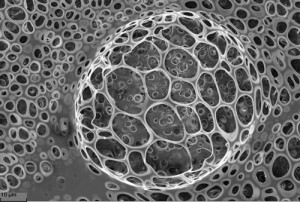This is the fourth annual outing for Ireland’s Nanoweek as the June 11, 2013 news item on Nanowerk notes,
NanoNet Ireland, the national network representing nanoscience across academia and industry, today launched Nanoweek 2013, which will take place from 14th – 21st June. Now in its fourth year, Nanoweek will celebrate the importance of nanoscience to the Irish economy; the excellence of nanoscience research within our universities, and look to grow public awareness of a technology which is fundamental to medicine, communications, pharmaceuticals, energy and transport among other industries.
The June 11, 2013 CRANN (Centre for Research on Adaptive Nanostructures and Nanodevices) news release, which originated the news item, notes that the organizers have introduced an international and cosmopolitan flavour to the proceedings as they are hosting a European meeting and their first ever outdoor ‘nano’ art exhibit (as well, it looks like they’re remounting the 2012 Magical Materials show mentioned in my Sept. 14, 2012 posting),
This year, Nanoweek 2013 goes international with the key event being Europe’s largest nanoscience meeting – EuroNanoForum 2013 – which takes place on 18th – 20th June at Dublin’s Convention Centre. The forum, which will include an opening address from Brussels by EU Commissioner for Science, Research and Innovation Máire Geoghegan Quinn, will attract over 1200 international delegates, 90 exhibitors and over 120 speakers. Dr. Mihail Roco, Senior Advisor at the National Science Foundation and National Nanotechnology Initiative USA, Prof. Andrea Ferrari, Director Cambridge Graphene Centre, as well as Professor Danias Pavalkis, Minister of Education & Science Lithuania, are among the key speakers, others include policy-makers and representatives from industry and academia. This event puts Ireland at the hub of the global nanoscience community in 2013.
…
Minister Sherlock [Minister for Research and Innovation, Seán Sherlock TD] added, “The sector has grown rapidly in the last decade from a niche industry, to one which now contributes €15 billion of our annual exports and supports 250,000 Irish jobs. The Government, primarily through Science Foundation Ireland, Enterprise Ireland and the HEA, is strongly committed to supporting Irish nanoscience and the further development of excellent research that delivers real economic and social impact for Ireland and Europe.”
Also, during Nanoweek 2013, Ireland’s first outdoor nano-art exhibition will take place in Dublin and Cork. Free to the public, NanoArt 2013 will see over 100 images taken from nanoscience research at CRANN, Tyndall National Institute, Cork and MSSI, University of Limerick, on display in the grounds of Trinity College Dublin, the Triskel Arts Centre, Cork and foyer of Tyndall National Institute. The images have been chosen to show the beauty of nano-landscapes and nano-structures and the scale at which nanoscience research is undertaken – up to 2,000 times smaller than a grain of salt – and to bring nanoscience to a wider public audience. The images will also be on display at a number of cafés and pubs around Dublin and Cork. Images are available online and viewers can enter a competition to vote for their favourite from Friday 14th at http://crann.tcd.ie/Research/Research-Image-Gallery/NanoArt2013.aspx. The exhibition in TCD, which will be located in Fellow’s Square, the green public area near the Book of Kells will run from 17th June until 5th July.
Professor John Boland, Director of CRANN, representing NanoNet Ireland said, “Nanoweek is about celebrating the impact of nanoscience both to the economy and for society. Ireland is a base for 90% of the world’s technology companies and 70% of medical companies, and the quality of our nanoscience research contributes to those companies locating and expanding here. The sector is crucial for our economy, and Nanoweek delivers that message to Government, to industry and to the public. As a sector that affects every product we consume, it’s important that public awareness of nanoscience grows. We wanted to develop a series of exhibitions that act as conversation starters about nanoscience. It’s only when people start discussing science, that it becomes a real option for study and work, and its potential impact can truly take off.”
On Thursday 20th June, the Convention Centre Dublin will also open its doors to the public for the Nanotech Europe 2013 Magical Materials exhibition from 9 am to 2.30 pm. The exhibition will explore the peculiar properties of the world’s most spectacular materials and will feature aerogel, the world’s lightest solid; graphene, 200 times stronger than steel and flexible screens made from nanowires. Free to the public and with limited space, visitors should register in advance at https://www.eventsforce.net/enterpriseireland/805/register.
I mentioned the EuroNanoForum in a March 14, 2013 posting. , which details some of the events including a presentation on the Graphene flagship project which just won a 1B Euro research prize. One of my favourite EuroNanoForum events is a gala that sounds like they’ve taken their inspiration from reality television. From my May 31, 2013 posting,
The aim of the award is to highlight the innovative outcomes of EU research projects and to present how nanotechnologies enable progress in every aspect of daily life: from health to environment, energy, transport, food and communication. The 11 candidates will be voted on and a winner announced at the ENF2013 on 20 June 2013. [emphasis mine]
It sounds like the entire voting process is going to take place at the dinner which should make for a very exciting gala event.
I have mentioned Ireland’s Nanoweek in previous years, 2012 and 2011.
I wish them all the best.
